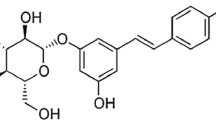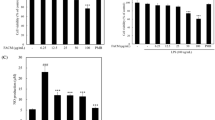Abstract
We have recently isolated and characterized the chemical structure of a bioactive Maillard reaction product, [5-(5,6-dihydro-4H-pyridin-3-ylidenemethyl)furan-2-yl]-methanol (F3-A), from an aqueous glucose (Glc) and lysine (Lys) Maillard reaction (MR) model system. Here, we investigate further the mechanisms for anti-inflammatory effects of this product in Caco-2 and RAW 264.7 cells. The anti-inflammatory capacity of F3-A recovered from Glc–Lys MR mixture and a synthesized product were compared with those of the specific inducible nitric oxide synthase (iNOS) inhibitor, aminoguanidine (AG), and the nuclear factor-kappa B (NF-κB) inhibitor, pyrrolidine dithiocarbamate (PDTC). F3-A produced a dose-dependent inhibition of extracellular nitric oxide (NO) production and iNOS translation in Caco-2 cells induced with interferon gamma (IFN-γ) and phorbol 12-myristate 13-acetate (PMA), and these effects were more potent than those obtained with AG. Moreover, a combination of F3-A and AG to attenuate intestinal inflammation was additive. However, F3-A inhibited only intracellular NO production in RAW 264.7 cells and did not inhibit COX-2 or NF-κB in either cell line. We conclude that the anti-inflammatory properties of F3-A are cell specific, working through different mechanism between macrophages and intestinal cells.







Similar content being viewed by others
Abbreviations
- AG:
-
Aminoguanidine
- COX-2:
-
Cyclooxygenase-2
- DAF-2:
-
4,5-Diaminofluorescein
- DAF-2DA:
-
4,5-Diaminofluorescein diacetate
- DAF-2T:
-
Triazolofluorescein
- DCM:
-
Dichloromethane
- DMEM:
-
Dulbecco’s modified Eagle’s medium
- FBS:
-
Fetal bovine serum
- F3-A:
-
[5-(5,6-Dihydro-4H-pyridin-3-ylidenemethyl)furan-2-yl]-methanol
- F3-AC19:
-
Isolated F3-A purified by flash chromatography
- F3-AS:
-
Synthesized F3-A
- Glc:
-
Glucose
- HMF:
-
Hydroxymethylfurfural
- HMFA:
-
5-Hydroxymethyl-2-furoic acid
- IBD:
-
Inflammatory bowel disease
- IECs:
-
Intestinal epithelial cells
- IFN-γ:
-
Interferon gamma
- IL-6:
-
Interleukin-6
- IL-8:
-
Interleukin 8
- iNOS:
-
Inducible nitric oxide synthase
- LPS:
-
Lipopolysaccharide
- Lys:
-
Lysine
- 3-MCP:
-
3-Methyl-1,2-cyclopentanedione
- MEM:
-
Minimum essential medium
- MR:
-
Maillard reaction
- MRPs:
-
Maillard reaction products
- MTT:
-
3-(4,5-Dimethylthiazol-2-yl)-2,5-diphenyltetrazolium bromide
- NF-κB:
-
Nuclear factor-kappa B
- NMR:
-
Nuclear magnetic resonance
- NO:
-
Nitric oxide
- NO2 − :
-
Nitrite
- NO3 − :
-
Nitrate
- NOD:
-
Nitric oxide dioxygenase
- PDTC:
-
Pyrrolidine dithiocarbamate
- PMA:
-
Phorbol 12-myristate 13-acetate
- Rf:
-
Retention factor
- RT-PCR:
-
Reverse transcription polymerase chain reaction
- TLC:
-
Thin layer chromatography
- TBST:
-
Tris-buffered saline-Tween
References
Liu J, Zhao S, Tang J, Li Z, Zhong T, Liu Y, Chen D, Zhao M, Li Y, Gong X (2009) Advanced glycation end products and lipopolysaccharide synergistically stimulate pro-inflammatory cytokine/chemokine production in endothelial cells via activation of both mitogen-activated protein kinases and nuclear factor-κB. FEBS J 276:4598–4606
Chang P, Chen T, Chang C, Hou C, Chan P, Lee H (2004) Advanced glycosylation end products induce inducible nitric oxide synthase (iNOS) expression via a p38 MAPK-dependent pathway. Kidney Int 65:1664–1675
Chung JH, Choi SY, Kim JY, Kim DH, Lee JW, Choi JS, Chung HY (2007) 3-Methyl-1, 2-cyclopentanedione down-regulates age-related NF-κB signaling cascade. J Agric Food Chem 55:6787–6792
Jin P, Kim J, Choi D, Lee Y, Jung HS, Hong JT (2013) Anti-inflammatory and anti-amyloidogenic effects of a small molecule, 2, 4-bis (p-hydroxyphenyl)-2-butenal in Tg2576 Alzheimer’s disease mice model. J Neuroinflamm 10:2
Chen X, Chen G, Chen H, Zhang Y, Kitts D (2015) Elucidation of the chemical structure and determination of the production conditions for a bioactive Maillard reaction product, [5-(5, 6-dihydro-4H-pyridin-3-ylidenemethyl) furan-2-yl]-methanol, isolated from a glucose-lysine heated mixture. J Agric Food Chem 63:1739–1746
Jobin C, Sartor RB (2000) The I kappa B/NF-kappa B system: a key determinant of mucosalinflammation and protection. Am J Physiol Cell Physiol 278:C451–C462
Clayburgh DR, Shen L, Turner JR (2004) A porous defense: the leaky epithelial barrier in intestinal disease. Lab Invest 84:282–291
Pull SL, Doherty JM, Mills JC, Gordon JI, Stappenbeck TS (2005) Activated macrophages are an adaptive element of the colonic epithelial progenitor niche necessary for regenerative responses to injury. Proc Natl Acad Sci USA 102:99–104
Alican I, Kubes P (1996) A critical role for nitric oxide in intestinal barrier function and dysfunction. Am J Physiol Gastrointest Liver Physiol 33:G225
Marion R, Coeffier M, Leplingard A, Favennec L, Ducrotte P, Dechelotte P (2003) Cytokine-stimulated nitric oxide production and inducible NO-synthase mRNA level in human intestinal cells: lack of modulation by glutamine. Clin Nutr 22:523–528
Kimura H, Hokari R, Miura S, Shigematsu T, Hirokawa M, Akiba Y, Kurose I, Higuchi H, Fujimori H, Tsuzuki Y, Serizawa H, Ishii H (1998) Increased expression of an inducible isoform of nitric oxide synthase and the formation of peroxynitrite in colonic mucosa of patients with active ulcerative colitis. Gut 42:180–187
Singer II, Kawka DW, Scott S, Weidner JR, Mumford RA, Riehl TE, Stenson WF (1996) Expression of inducible nitric oxide synthase and nitrotyrosine in colonic epithelium in inflammatory bowel disease. Gastroenterology 111:871–885
Chen X, Kitts DD (2008) Determining conditions for nitric oxide synthesis in Caco-2 cells using Taguchi and factorial experimental designs. Anal Biochem 381:185–192
Kim J, Han A, Park E, Kim J, Cho W, Lee J, Seo E, Lee K (2007) Inhibition of LPS-induced iNOS, COX-2 and cytokines expression by poncirin through the NF-KAPPA B Inactivation in RAW 264.7 Macrophage Cells. Biol Pharm Bull 30:2345–2351
Chen X, Kitts DD (2012) Characterization of antioxidant and anti-inflammatory activities of bioactive fractions recovered from a glucose–lysine Maillard reaction model system. Mol Cell Biochem 364:147–157
Hu C, Zawistowski J, Ling W, Kitts DD (2003) Black rice (Oryza sativa L. indica) pigmented fraction suppresses both reactive oxygen species and nitric oxide in chemical and biological model systems. J Agric Food Chem 51:5271–5277
Alderton W, Cooper C, Knowles R (2001) Nitric oxide synthases: structure, function and inhibition. Biochem J 357:593–615
Chin MP, Schauer DB, Deen WM (2010) Nitric oxide, oxygen, and superoxide formation and consumption in macrophages and colonic epithelial cells. Chem Res Toxicol 23:778–787
Lewis RS, Tamir S, Tannenbaum SR, Deen WM (1995) Kinetic analysis of the fate of nitric oxide synthesized by macrophages in vitro. J Biol Chem 270:29350–29355
Subczynski WK, Lomnicka M, Hyde JS (1996) Permeability of nitric oxide through lipid bilayer membranes. Free Radic Res 24:343–349
Lymar SV, Hurst JK (1996) Carbon dioxide: physiological catalyst for peroxynitrite-mediated cellular damage or cellular protectant? Chem Res Toxicol 9:845–850
Gardner PR, Martin LA, Hall D, Gardner AM (2001) Dioxygen-dependent metabolism of nitric oxide in mammalian cells. Free Radic Biol Med 31:191–204
Gardner PR, Gardner AM, Martin LA, Dou Y, Li T, Olson JS, Zhu H, Riggs AF (2000) Nitric-oxide dioxygenase activity and function of flavohemoglobins. Sensitivity to nitric oxide and carbon monoxide inhibition. J Biol Chem 275:31581–31587
Stuehr DJ, Marletta MA (1985) Mammalian nitrate biosynthesis: mouse macrophages produce nitrite and nitrate in response to Escherichia coli lipopolysaccharide. Proc Natl Acad Sci USA 82:7738–7742
Stuehr DJ, Marletta MA (1987) Synthesis of nitrite and nitrate in murine macrophage cell lines. Cancer Res 47:5590–5594
Tayeh MA, Marletta MA (1989) Macrophage oxidation of l-arginine to nitric oxide, nitrite, and nitrate. Tetrahydrobiopterin is required as a cofactor. J Biol Chem 264:19654–19658
Iyengar R, Stuehr DJ, Marletta MA (1987) Macrophage synthesis of nitrite, nitrate, and N-nitrosamines: precursors and role of the respiratory burst. Proc Natl Acad Sci USA 84:6369–6373
Hu C, Kitts DD (2004) Luteolin and luteolin-7-O-glucoside from dandelion flower suppress iNOS and COX-2 in RAW264. 7 cells. Mol Cell Biochem 265:107–113
Chen X, Zong C, Gao Y, Cai R, Fang L, Lu J, Liu F, Qi Y (2014) Curcumol exhibits anti-inflammatory properties by interfering with the JNK-mediated AP-1 pathway in lipopolysaccharide-activated RAW264. 7 cells. Eur J Pharmacol 723:339–345
Uwai K, Osanai Y, Imaizumi T, Kanno S, Takeshita M, Ishikawa M (2008) Inhibitory effect of the alkyl side chain of caffeic acid analogues on lipopolysaccharide-induced nitric oxide production in RAW264. 7 macrophages. Bioorg Med Chem 16:7795–7803
Pautz A, Art J, Hahn S, Nowag S, Voss C, Kleinert H (2010) Regulation of the expression of inducible nitric oxide synthase. Nitric Oxide 23:75–93
Acknowledgments
This study was supported by a NSERC-discovery grant to DDK. We also thank Yongting Chen for help with protein and mRNA extraction.
Compliance with Ethical Standards
This article does not contain any studies with human participants or animals performed by any of the authors.
Conflict of interest
The authors declare no conflict of interest.
Author information
Authors and Affiliations
Corresponding author
Rights and permissions
About this article
Cite this article
Chen, XM., Kitts, D.D. Evidence for inhibition of nitric oxide and inducible nitric oxide synthase in Caco-2 and RAW 264.7 cells by a Maillard reaction product [5-(5,6-dihydro-4H-pyridin-3-ylidenemethyl)furan-2-yl]-methanol. Mol Cell Biochem 406, 205–215 (2015). https://doi.org/10.1007/s11010-015-2438-7
Received:
Accepted:
Published:
Issue Date:
DOI: https://doi.org/10.1007/s11010-015-2438-7




